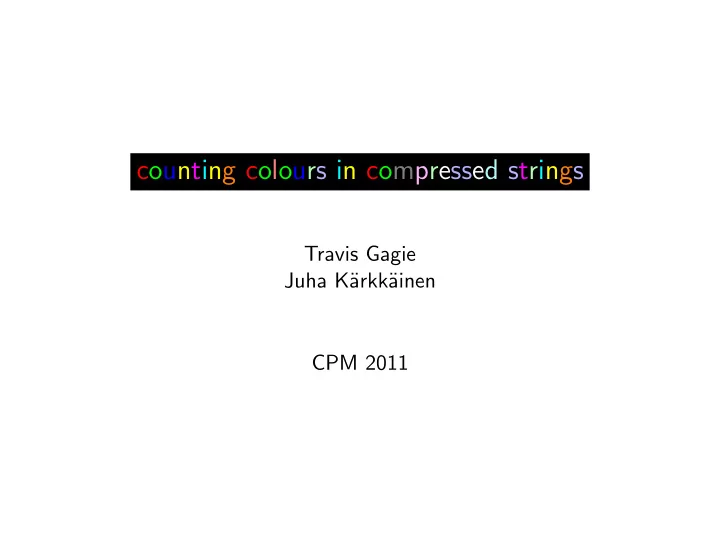

counting colours in compressed strings Travis Gagie Juha K¨ arkk¨ ainen CPM 2011
counting colours in compressed strings Travis Gagie Juha K¨ arkk¨ ainen CPM 2011
Theorem Given a string s [1 .. n ] , we can build a data structure that takes nH 0 ( s ) + O ( n ) + o ( nH 0 ( s )) bits such that later, given a substring’s endpoints i and j, in O (log ℓ ) time we can count how many distinct characters it contains, where ℓ = j − i + 1 .
source space time BKM&T O ( n log n ) O (log n ) Muthu + WT n log n + o ( n log n ) O (log n ) GN&P n log σ + O ( n log log n ) O (log n ) this paper nH 0 ( s ) + O ( n ) + o ( nH 0 ( s )) O (log ℓ )
counting colours in compressed strings [c, o, u, n, t, i, n, g, c, o, l, o, u, r, s, i, n, c, o, m, p, r, e, s, s, e, d, s, t, r, i, n, g, s] [0, 0, 0, 0, 0, 0, 4, 0, 1, 2, 0, 10, 3, 0, 0, 6, 7, 9, 12, 0, 0, 14, 0, 15, 24, 23, 0, 25, 5, 22, 16, 17, 28]
counting colours in compressed strings [c, o, u, n, t, i, n, g, c, o, l, o, u, r, s, i, n, c, o, m, p, r, e, s, s, e, d, s, t, r, i, n, g, s] [0, 0, 0, 0, 0, 0, 4, 0, 1, 2, 0, 10, 3, 0, 0, 6, 7, 9, 12, 0, 0, 14, 0, 15, 24, 23, 0, 25, 5, 22, 16, 17, 28]
counting colours in compressed strings [c, o, u, n, t, i, n, g, c, o, l, o, u, r, s, i, n, c, o, m, p, r, e, s, s, e, d, s, t, r, i, n, g, s] [0, 0, 0, 0, 0, 0, 4, 0, 1, 2, 0, 10, 3, 0, 0, 6, 7, 9, 12, 0, 0, 14, 0, 15, 24, 23, 0, 25, 5, 22, 16, 17, 28]
source space time BKM&T O ( n log n ) O (log n ) Muthu + WT n log n + o ( n log n ) O (log n ) GN&P n log σ + O ( n log log n ) O (log n ) this paper nH 0 ( s ) + O ( n ) + o ( nH 0 ( s )) O (log ℓ )
source space time BKM&T O ( n log n ) O (log n ) Muthu + WT n log n + o ( n log n ) O (log n ) GN&P n log σ + O ( n log log n ) O (log n ) this paper nH 0 ( s ) + O ( n ) + o ( nH 0 ( s )) O (log ℓ )
a a b b 5 3 3 5 5 3 . . . . . . 5 . . . . . .
a b b a 5 9 9 5 9 . . . . . . 5
Components: ◮ multiary wavelet tree assigning entries to blocks ◮ wavelet tree for each block (with a shared bitvector for each block size and depth)
Observations: ◮ if we use more block sizes, the C array becomes more like recency coding and compression is better (but queries take more time) ◮ if we use polylog( n ) block sizes, then we can count the entries much bigger than ℓ in O (1) time using the multiary wavelet tree
Calculation: ◮ if we use block sizes � 2 k = 1 b k = 2 max ( � k − 1 h =1 (1+1 /α ( b h )) , k ) k > 1 then we use a total of nH 0 ( s ) + O ( n ) + o ( nH 0 ( s )) bits and O ( α ( ℓ ) log ℓ log log( ℓ + 1)) query time
Observations: ◮ if a block B smaller than ℓ contains the beginning i of the interval, then it does not contain the end j ◮ we can count the entries C [ q ] = p in B with p < i ≤ q by counting ◮ all the entries in B (in O (1) time with the multiary wavelet tree) ◮ all the entries in B with q < i (in O (1) time with the multiary wavelet tree) ◮ all the entries in B with p ≥ i
Calculation: ◮ if we store pointers to the wavelet-tree nodes at height k , then we use O ( n ) more bits and can count all the entries in B α ( ℓ )(log log( ℓ + 1)) 2 � � with p ≥ i in O ⊆ o (log ℓ ) time
source space time BKM&T O ( n log n ) O (log n ) Muthu + WT n log n + o ( n log n ) O (log n ) GN&P n log σ + O ( n log log n ) O (log n ) this paper nH 0 ( s ) + O ( n ) + o ( nH 0 ( s )) O (log ℓ )
Recommend
More recommend